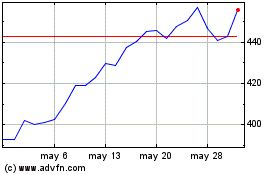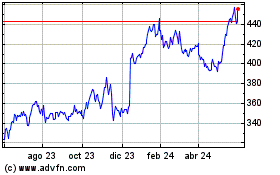- Eligible transfusion-dependent beta
thalassemia (TDT) patients in England will be able to access the
therapy from today -
- CASGEVY is one of the first medicines funded
by NHS England’s Innovative Medicines Fund -
Vertex Pharmaceuticals (Nasdaq: VRTX) announced today a
reimbursement agreement with NHS England for eligible
transfusion-dependent beta thalassemia (TDT) patients to access the
CRISPR/Cas9 gene-edited therapy, CASGEVY™ (exagamglogene
autotemcel), from today.
The reimbursement agreement comes as the National Institute for
Health and Care Excellence (NICE) issues positive guidance
recommending CASGEVY’s use in the NHS.
The United Kingdom (U.K.) Medicines and Healthcare products
Regulatory Agency (MHRA) granted CASGEVY the first authorization in
the world for a CRISPR-based gene-editing therapy on November 15,
2023.
“Securing access to CASGEVY is a historic moment for people
living with transfusion-dependent beta thalassemia who, for too
long, have had limited options for this life-shortening disease,”
said Ludovic Fenaux, Senior Vice President, Vertex International.
“Through collaboration with NHS England and NICE, we have reached
this landmark agreement that recognizes the value a one-time
treatment can provide to patients, their families and the health
care system.”
The administration of the therapy requires experience in stem
cell transplantation and the management of hemoglobinopathies;
therefore, Vertex is engaging with experienced hospitals throughout
England to establish a network of independently operated authorized
treatment centers (ATCs).
Vertex continues to work collaboratively with NICE and NHS
England to ensure eligible sickle cell disease (SCD) patients in
England can also access this treatment as soon as possible. In the
European Union, Vertex is working closely with reimbursement
authorities to bring this innovative therapy to eligible SCD and
TDT patients rapidly as the company has done in the United States,
the Kingdom of Saudi Arabia and Bahrain.
About Transfusion-Dependent Beta Thalassemia (TDT)
TDT is a serious, life-threatening genetic disease. TDT patients
report health-related quality of life scores below the general
population and significant health care resource utilization. TDT
requires frequent blood transfusions and iron chelation therapy
throughout a person’s life. Due to anemia, patients living with TDT
may experience fatigue and shortness of breath, and infants may
develop failure to thrive, jaundice and feeding problems.
Complications of TDT can also include an enlarged spleen, liver
and/or heart, misshapen bones and delayed puberty. TDT requires
lifelong treatment and significant use of health care resources,
and ultimately results in reduced life expectancy, decreased
quality of life and reduced lifetime earnings and productivity. In
Europe, the mean age of death for patients living with TDT is 50-55
years. Stem cell transplant from a matched donor is a potentially
curative option but is only available to a small fraction of people
living with TDT because of the lack of available donors.
About CASGEVY™ (exagamglogene autotemcel [exa-cel])
CASGEVY™ is a non-viral, ex vivo CRISPR/Cas9 gene-edited cell
therapy for eligible patients with SCD or TDT, in which a patient’s
own hematopoietic stem and progenitor cells are edited at the
erythroid specific enhancer region of the BCL11A gene through a
precise double-strand break. This edit results in the production of
high levels of fetal hemoglobin (HbF; hemoglobin F) in red blood
cells. HbF is the form of the oxygen-carrying hemoglobin that is
naturally present during fetal development, which then switches to
the adult form of hemoglobin after birth. CASGEVY has been shown to
reduce or eliminate vaso-occlusive crises (VOCs) for patients with
SCD and transfusion requirements for patients with TDT.
CASGEVY is approved for certain indications in multiple
jurisdictions for eligible patients.
In Great Britain, CASGEVY was granted Conditional Marketing
Authorization for the treatment of patients 12 years of age and
older with either TDT or SCD with recurrent vaso-occlusive crises
who have the βS/βS, βS/β+ or βS/β0 genotype, for whom hematopoietic
stem cell transplantation is appropriate and a human leukocyte
antigen matched related hematopoietic stem cell donor is not
available.
About Vertex
Vertex is a global biotechnology company that invests in
scientific innovation to create transformative medicines for people
with serious diseases. The company has approved medicines that
treat the underlying causes of multiple chronic, life-shortening
genetic diseases — cystic fibrosis, sickle cell disease and
transfusion-dependent beta thalassemia — and continues to advance
clinical and research programs in these diseases. Vertex also has a
robust clinical pipeline of investigational therapies across a
range of modalities in other serious diseases where it has deep
insight into causal human biology, including acute and neuropathic
pain, APOL1-mediated kidney disease, IgA nephropathy, autosomal
dominant polycystic kidney disease, type 1 diabetes, myotonic
dystrophy type 1 and alpha-1 antitrypsin deficiency.
Vertex was founded in 1989 and has its global headquarters in
Boston, with international headquarters in London. Additionally,
the company has research and development sites and commercial
offices in North America, Europe, Australia, Latin America and the
Middle East. Vertex is consistently recognized as one of the
industry's top places to work, including 14 consecutive years on
Science magazine's Top Employers list and one of Fortune’s 100 Best
Companies to Work For. For company updates and to learn more about
Vertex's history of innovation, visit www.vrtx.com or follow us on
LinkedIn, YouTube and Twitter/X.
(VRTX-GEN)
Vertex Special Note Regarding Forward-Looking
Statements
This press release contains forward-looking statements as
defined in the Private Securities Litigation Reform Act of 1995, as
amended, including, without limitation, the statements by Ludovic
Fenaux, in this press release, and statements regarding our
expectations for and the anticipated benefits of CASGEVY, our
expectations for the anticipated timeline for eligible TDT patients
in England to have access to CASGEVY, our plans to engage with
experienced hospitals throughout England to establish an ATC
network, our plans to continue working with NICE and NHS England to
ensure eligible SCD patients in England can access CASGEVY as soon
as possible, and our plans to work with reimbursement authorities
in the European Union to bring CASGEVY to eligible SCD and TDT
patients. While we believe the forward-looking statements contained
in this press release are accurate, these forward-looking
statements represent the company's beliefs only as of the date of
this press release and there are a number of risks and
uncertainties that could cause actual events or results to differ
materially from those expressed or implied by such forward-looking
statements. Those risks and uncertainties include, among other
things, that eligible patient access to CASGEVY may not be achieved
on the anticipated timeline, or at all, that data from the
company's development programs may not support registration or
further development of its compounds due to safety, efficacy, and
other reasons, and other risks listed under the heading “Risk
Factors” in Vertex's most recent annual report and subsequent
quarterly reports filed with the Securities and Exchange Commission
at www.sec.gov and available through the company's website at
www.vrtx.com. You should not place undue reliance on these
statements. Vertex disclaims any obligation to update the
information contained in this press release as new information
becomes available.
View source
version on businesswire.com: https://www.businesswire.com/news/home/20240723935185/en/
Vertex Pharmaceuticals Incorporated Investors:
InvestorInfo@vrtx.com
Media: mediainfo@vrtx.com or International: +44 20 3204
5275 or U.S.: 617-341-6992 or Heather Nichols: +1 617-839-3607
Vertex Pharmaceuticals (NASDAQ:VRTX)
Gráfica de Acción Histórica
De Dic 2024 a Ene 2025

Vertex Pharmaceuticals (NASDAQ:VRTX)
Gráfica de Acción Histórica
De Ene 2024 a Ene 2025
